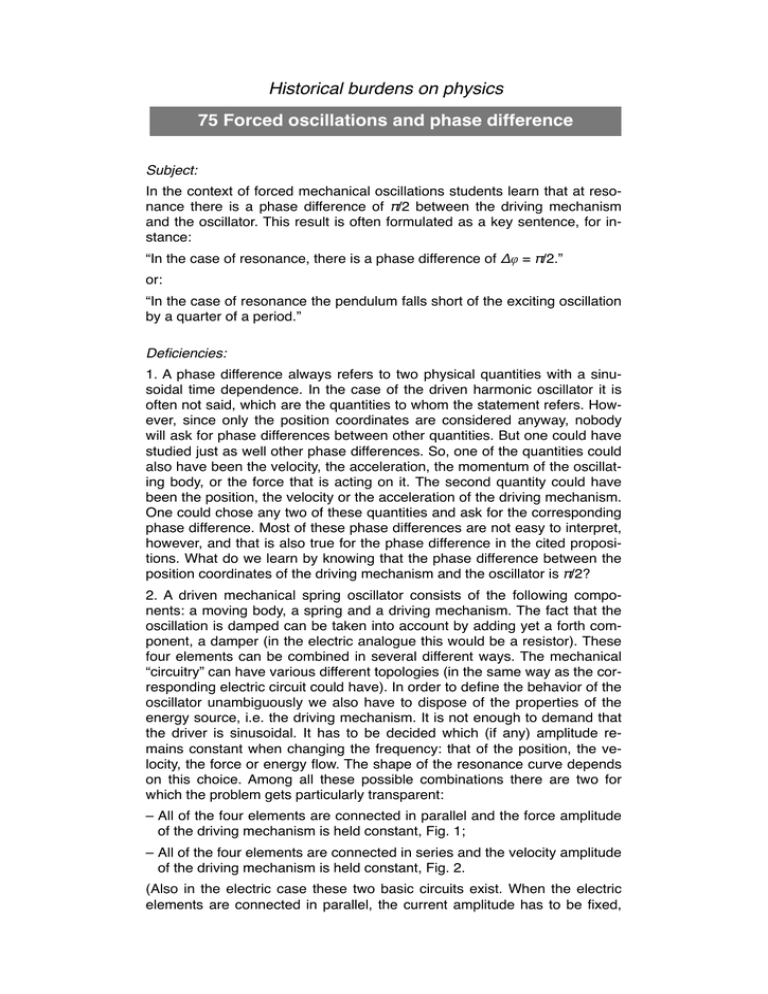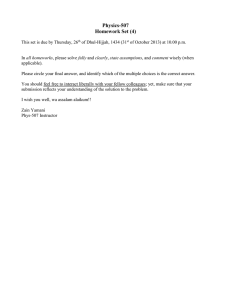75. Forced oscillations and phase difference
advertisement

Historical burdens on physics 75 Forced oscillations and phase difference Subject: In the context of forced mechanical oscillations students learn that at resonance there is a phase difference of π/2 between the driving mechanism and the oscillator. This result is often formulated as a key sentence, for instance: “In the case of resonance, there is a phase difference of Δφ = π/2.” or: “In the case of resonance the pendulum falls short of the exciting oscillation by a quarter of a period.” Deficiencies: 1. A phase difference always refers to two physical quantities with a sinusoidal time dependence. In the case of the driven harmonic oscillator it is often not said, which are the quantities to whom the statement refers. However, since only the position coordinates are considered anyway, nobody will ask for phase differences between other quantities. But one could have studied just as well other phase differences. So, one of the quantities could also have been the velocity, the acceleration, the momentum of the oscillating body, or the force that is acting on it. The second quantity could have been the position, the velocity or the acceleration of the driving mechanism. One could chose any two of these quantities and ask for the corresponding phase difference. Most of these phase differences are not easy to interpret, however, and that is also true for the phase difference in the cited propositions. What do we learn by knowing that the phase difference between the position coordinates of the driving mechanism and the oscillator is π/2? 2. A driven mechanical spring oscillator consists of the following components: a moving body, a spring and a driving mechanism. The fact that the oscillation is damped can be taken into account by adding yet a forth component, a damper (in the electric analogue this would be a resistor). These four elements can be combined in several different ways. The mechanical “circuitry” can have various different topologies (in the same way as the corresponding electric circuit could have). In order to define the behavior of the oscillator unambiguously we also have to dispose of the properties of the energy source, i.e. the driving mechanism. It is not enough to demand that the driver is sinusoidal. It has to be decided which (if any) amplitude remains constant when changing the frequency: that of the position, the velocity, the force or energy flow. The shape of the resonance curve depends on this choice. Among all these possible combinations there are two for which the problem gets particularly transparent: –!All of the four elements are connected in parallel and the force amplitude of the driving mechanism is held constant, Fig. 1; –!All of the four elements are connected in series and the velocity amplitude of the driving mechanism is held constant, Fig. 2. (Also in the electric case these two basic circuits exist. When the electric elements are connected in parallel, the current amplitude has to be fixed, when connected in series, the voltage of the energy source is held constant.) Now, the statements cited above are not valid for either of these basic circuits, but for a hybrid of the parallel and the series circuit. Correspondingly, the interpretation of the statement about the phase difference is somewhat difficult. On the contrary, in the case of either of the basic circuits the interpretation is simple. We shall discuss the example of the parallel circuit, Fig. 1. Resonance means that the time average of the energy flow from the driving mechanism (index D) to the oscillator P = v DFD has a maximum value. With v D = vˆD sin(ωt ) and FD = F̂D sin(ωt – φ ) we get P= vˆDF̂D cos φ . 2 In this expression all of the three factors, namely vˆD , F̂D and cosφ can in principle depend on frequency. For the “parallel oscillator”, Fig. 1, the force amplitude F̂D is held constant, it is independent of the frequency. Each of the other two factors have a maximum value at the resonance frequency. Thus for the resonance we have cosφ = 1, or φ = 0. That means that the velocity of the driving mechanism and the force which it exerts on the oscillator are “in phase”. This statement is plausible. In order to excite or drive an oscillator most effectively one has to push or pull most strongly when the oscillator moves most quickly. Fig. 1. Parallel oscillator has constant driving force amplitude. For the series oscillator, Fig. 2, the velocity amplitude is frequencyindependent. The force amplitude and cosφ both have a maximum value at the resonance frequency and again we have φ = 0. Fig. 2. Series oscillator has constant velocity amplitude. The oscillator topology that most often is considered in mechanics is that of Fig. 3. It can be shown that this oscillator is mathematically equivalent to the parallel oscillator. For the force one has to write D x̂ D sin(ωt ) . In the case of resonance this force is in phase with the velocity of the oscillator. This fact can be justified in the same way as the zero phase difference for the parallel circuit. Since the phase difference between position and velocity of the oscillator is π/2, the statement of the citations at the beginning follows. Fig. 3. Hybrid form of parallel and series oscillator. Origin: See our previous article [1]. Putting the position amplitudes of the driving mechanism and the oscillator in the center of attention corresponds to the tradition of mechanics to consider a problem as solved when the positiontime relation is determined, i.e. when we have calculated what we see with our eyes. However, we understand mechanics better when putting in the fore the quantities momentum and energy and the respective flows. Disposal: Considering a phase difference as a function of the excitation frequency is worthwhile only if the corresponding function is interpreted. It is easy to interpret the phase difference between the force and the velocity. The product of them is the flow of the dissipated energy. A phase difference of zero contributes to make this product a maximum for the resonance frequency. [1] Historical burdens on physics: 50 Resonant frequency and natural frequency Friedrich Herrmann and Holger Hauptmann, Karlsruhe Institute of Technology




